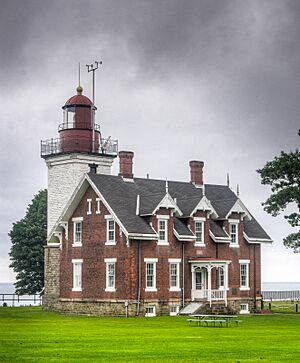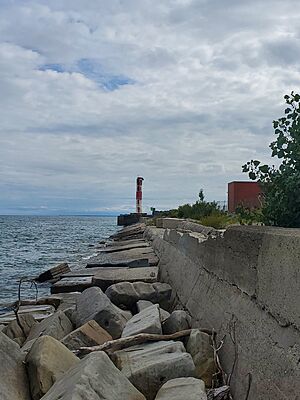Dunkirk Light facts for kids
 |
|
| Location | 1 Lighthouse Point Drive, Dunkirk, New York, Point Gratiot on Lake Erie |
|---|---|
| Coordinates | 42°29′38″N 79°21′14″W / 42.49389°N 79.35389°W |
| Year first lit | 1875 |
| Automated | 1960 |
| Foundation | Dressed Stone |
| Construction | Rubblestone encased in brick |
| Tower shape | Square |
| Markings / pattern | Upper 2/3 White, lower 1/3 natural, Red Lantern |
| Focal height | 82 feet (25 m) |
| Original lens | Third Order Fresnel lens |
| Characteristic | Occulting White 4 seconds |
The Dunkirk Lighthouse, also known as the Point Gratiot Light, is a working lighthouse. It stands on Point Gratiot by Lake Erie in New York state.
The first lighthouse was built here in 1826. The tower you see today was first lit in 1875. This lighthouse became automated in 1960 and still helps ships today. Its base is made of cut stone. The tower itself is built from rough stones covered in brick. It has a square shape. The top two-thirds are white, and the bottom third is natural stone. The light's housing is red.
A special lens called a third-order Fresnel lens was put in the original lighthouse in 1857. This same lens is still used in the current tower. It is quite rare to find such an old lens still working. Only about 70 of these lenses are still in use across the United States. Sixteen of them are on the Great Lakes, and two are in New York. The Dunkirk Lighthouse was added to the National Register of Historic Places in 1979. It is known as the Point Gratiot Lighthouse Complex.
Contents
History of the Lighthouse
The Dunkirk Lighthouse has a long and interesting past.
Early Problems and Rebuilding
Before the current lighthouse was built, the old one was in bad shape. In 1868, officials noted that the keeper's house leaked. The tower itself had cracks. They said the lighthouse needed repairs. By 1874, the situation was even worse. Reports said the old tower was very unsafe. Large pieces of its outer wall could fall off. It was strongly suggested that a new tower be built quickly. About $15,000 was needed for this project.
The new lighthouse was finished in 1875. The valuable third-order Fresnel lens from the 1857 lighthouse was moved to the new one. This lens is still in use today. It is worth a lot of money, about $1.5 million.
Changes Over Time
In 1960, the lighthouse became automated. This meant it no longer needed a keeper to operate it. At that time, the house where the assistant keeper lived was taken down.
After the lighthouse was automated, local people stepped in. They bought the property and fixed up the building. Now, volunteers run it as a lighthouse and veteran's museum. In 2022, the Dunkirk Planning Board approved plans for a new pavilion. This pavilion can be used for weddings and other outdoor events.
Guiding Ships: Pier-head Light
The Dunkirk Lighthouse worked with another light to guide ships. This was the Dunkirk Pier-head light. The assistant lighthouse keeper used to operate this light.
There have been five different towers for the pier-head light. The first two were destroyed by ice from the lake. The third one was removed in 1939. A metal tower replaced it. That metal tower was later replaced by the current one. The old metal tower now sits on the Dunkirk Lighthouse property.
Veteran's Museum
The second floor of the original keeper's house is now a veteran's museum. Each of the four rooms is dedicated to a different branch of the armed forces. There is also another building with items from the Coast Guard. The hallway has an exhibit about the Vietnam War. Most of the items in the museum were given by local people. Some were donated by the United States Coast Guard.
Visiting the Lighthouse
The Dunkirk Lighthouse is open for visitors from May through October. In spring and fall, it is open from 10:00 AM to 2:00 PM. During the summer, it is open from 10:00 AM to 4:00 PM.
When you visit, you can take a guided tour. This tour includes climbing to the top of the lighthouse. You can also explore the keeper's house and the Veteran's Museum. There is also a gift shop. The lighthouse is also known for private ghost investigations. Public ghost tours are offered in the fall by local paranormal groups.
The Archives Center at the Smithsonian National Museum of American History has a collection of souvenir postcards of lighthouses. They have put 272 of these online. This includes postcards of the Dunkirk (Point Gratiot) Lighthouse.


